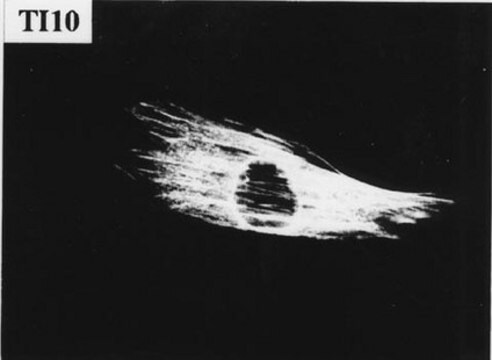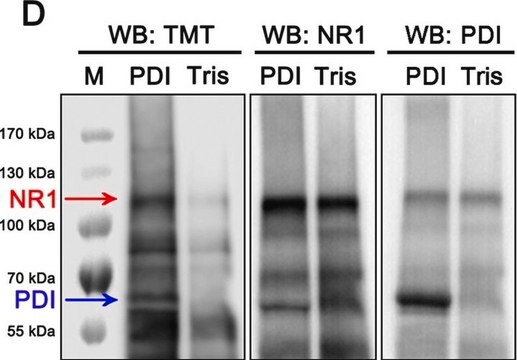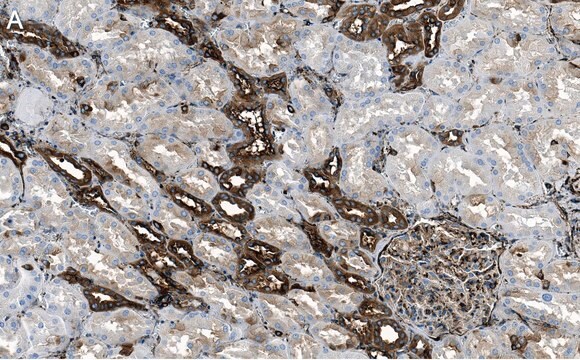MAB1678
Anti-Filamin A Antibody, clone PM6/317
ascites fluid, clone PM6/317, Chemicon®
Synonym(s):
Alpha-Filamin, Filamin I, Endothelial Actin-binding Protein, ABP-280, Nonmuscle Filamin
About This Item
Recommended Products
biological source
mouse
antibody form
ascites fluid
antibody product type
primary antibodies
clone
PM6/317, monoclonal
species reactivity
human, rabbit, rat, guinea pig, chicken, mouse
manufacturer/tradename
Chemicon®
technique(s)
immunofluorescence: suitable
immunohistochemistry (formalin-fixed, paraffin-embedded sections): suitable
immunoprecipitation (IP): suitable
western blot: suitable
isotype
IgG1
NCBI accession no.
UniProt accession no.
shipped in
wet ice
target post-translational modification
unmodified
Gene Information
human ... FLNA(2316)
mouse ... Flna(192176)
General description
Specificity
Immunogen
Application
1:1000-1:4000. Because of the large size of the unprocessed forms of filamin, 4-7% PAGE gels and proteinase inhibitors are recommended.
Immunofluorescence:
1:50-1:200 dilution from a previous lot was used. Suitable for staining both frozen and paraffin embedded tissues (at lower dilutions). Microwave-citrate buffer antigen retrieval method recommended for paraffin sections.
Immunoprecipitation:
A previous lot was used on immunoprecipitation. Suggested lysis buffer is PBS with 0.5% triton X-100 with proteinase inhibitors (note for full length filamin include calpain inhibitors). 5 microliters of antibody for every 300-500 μL of cell lysate (200-500 μg/mL total protein is suggested. Incubation is 1 hour RT or overnight 4C; Protein A/G agarose beads or rabbit anti-mouse secondary capture antibody is recommended for best recovery. 4-8% acrylamide gels are recommended for full length filamin or the 190 kDa fragement visualization.
Optimal working dilutions must be determined by end user.
Cell Structure
Cytoskeleton
Quality
Western Blot Analysis:
1:500-1:4000 dilution of this lot detected Filamin A on 10 μg of Jurkat lysates. Because of the large size of the unprocessed forms of filamin, 4-7% PAGE gels and proteinase inhibitors are recommended.
Target description
Physical form
Storage and Stability
Handling Recommendations: Upon first thaw, and prior to removing the cap, centrifuge the vial and gently mix the solution. Aliquot into microcentrifuge tubes and store at -20°C. Avoid repeated freeze/thaw cycles, which may damage IgG and affect product performance.
Analysis Note
Positive control tisse: skin, jurkat cell lysate.
Other Notes
Legal Information
Disclaimer
Not finding the right product?
Try our Product Selector Tool.
recommended
Storage Class Code
12 - Non Combustible Liquids
WGK
nwg
Flash Point(F)
Not applicable
Flash Point(C)
Not applicable
Certificates of Analysis (COA)
Search for Certificates of Analysis (COA) by entering the products Lot/Batch Number. Lot and Batch Numbers can be found on a product’s label following the words ‘Lot’ or ‘Batch’.
Already Own This Product?
Find documentation for the products that you have recently purchased in the Document Library.
Our team of scientists has experience in all areas of research including Life Science, Material Science, Chemical Synthesis, Chromatography, Analytical and many others.
Contact Technical Service








